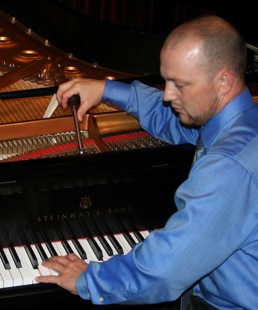The approximately 200 strings on your piano usually exert between 30,000 and 40,000 pounds of tension on the plate and frame, and about 600 pounds of down bearing force on the bridges and soundboard. Seasonal changes in the humidity as well as the continual decrease of static tension (due in part to the bending of the strings around their bearing points) causes pianos to go out of tune.
Depending upon where you live, the degree of humidity change from season to season, the quality and condition of your piano and any exceptionally heavy play, you may need piano tuning two to four (or more) times per year. During an initial service call, I will check and tighten the plate bolts, pin block bolts (and rim bolts in grand pianos), assess pinblock stability, inspect your piano for necessary repairs and adjustments, and finally, perform a piano tuning to have your piano sounding nice and at A-440 standard pitch.
Sometimes you need more than a piano tuning. If your piano is not reasonably close to standard pitch to begin with, it will require a pitch correction. Usually an instrument that is tuned at least annually will not require the additional pitch-correction service. However, some instruments in some environments may even need pitch corrections if they do not receive service at least every 4 to 6 months. These situations are not the norm, but they do occur. Every situation is unique, however, from piano to piano and home to home.
How can you guarantee that your piano will stay sounding good from one tuning to the next?
Install a Piano Life Saver humidity control system in your piano. The Piano Life Saver is designed to create a micro-environment around your piano and maintains a constant Relative Humidity (RH) regardless what time of year it is, or what nature is doing. Pianos that I service with humidity control are more closely in tune at an annual appointment than the same piano without humidity control, seen every six months.



